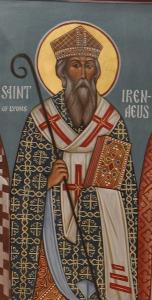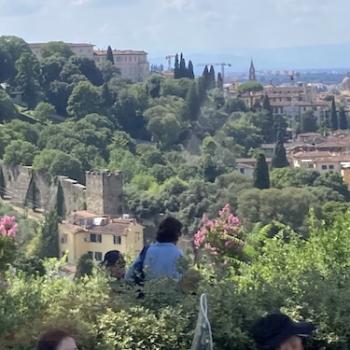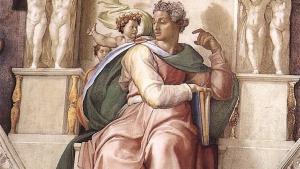“He appeared as human in the fulness of time, and, being God’s Word, he summed up in Himself all things in heaven and on earth. He united humans with God and brought about communion between God and humans.” -St. Irenaeus of Lyon

Why I need Irenaeus
Many years ago I sat with a spiritual director and tried to describe a difficult moment in my life. I say “tried,” because I was feeling overwhelmed, and having a tough time putting it all into words. For a moment I thought he too was feeling overwhelmed, as he sat and listened thoughtfully. Then he asked me a question. “I see. That’s all very hard, and even hard to follow. But can you imagine Jesus standing in the middle of this experience?” I laughed—at myself, not at him—and said, “No! I don’t want Jesus anywhere near all that!”
Irenaeus of Lyon wrote his theology for people like me. People, I mean, who want the healing of wounds and the kingdom of peace that the gospel promises. But who want it by avoiding the painful moments of embodied life. We like to imagine that God can meet us only when we get away from all that is challenging and even ugly about life in the world. Irenaeus wrote what is sometimes called the first systematic theology for those tempted by this disembodied spiritualism. He wrote to help those of us tempted by escapism to understand what the story of the Incarnation was really about.
He was “of Lyon” not originally, but sent there—to Gaul— as a missionary bishop in the later 2d century. Originally he came from Smyrna, in what is now Turkey, on the eastern shore of the Aegean Sea. Eusebius, one of the early church historians, says that he studied under Polycarp, the famous martyr of Smyrna. Saint Jerome, another of the historians, tells us that Polycarp was a student a St. John the Evangelist—yes, that John. That’s pretty strong pedigree.
Staying with the Body
Literally accurate or not, that Johannine pedigree shows up in Irenaeus’s book. He wrote against the Christian Gnostics, whose basic idea was that salvation comes by escaping time and bodies. John took them on as well. John’s Gospel and Epistles teach a mysticism of embodiment. “Little children, I hope that you do not fall into sin; but if you do sin, there is forgiveness through the cross.” We are made to ascend into union with God, and to do so in the midst of, not outside of, complex human embodied life.
By Irenaeus’s day, the Gnostic mythology had grown pretty spectular. In one version of the creation/fall story, Sophia, the daughter of God, rebels and creates the material world. Logos, the Son of God, goes into the world to undo what she’s done, and to remove us from materiality. Making creation into a synonym of the fall was a typical Gnostic move. It means that salvation looks like an uncreating. Ireneaus fought hard against that idea.
The ugliest of the Gnostics was Marcion, who gave a name to the god of matter and evil: Yahweh. And he told us the name of that evil god’s scripture: Torah. On the opposite pole for him was Jesus, the true God, and the New Testament, his book. Irenaeus launched into a whole program of Biblical interpretation to show us that the Bible is one, and the God of the Bible is one. The New Testament fulfills, rather than abolishes, the Old. Handel’s Messiah owes its hermeneutic to Irenaeus’s mad takedown of Marcion.
The Way of the Patient God
Sin, in his theology, is real and devasting, but also something like immaturity or impatience. We ate the fruit because we wanted to be deified immediately. God, on the other hand, is patience itself. God sees the sin of the garden, and finds it not to be an act to punish, but a thing to endure. Reminding us of Genesis 3:22, Irenaeus says the point of the exile from Eden was to keep us from the other tree, the Tree of Life. If we ate of that one, in our fallen state, the disobedience itself would become immortal. The angels guard the tree so that we can change, repent, and mature as God’s creation. So we can be saved through our bodies.
And so, “in the fulness of time,” God enters the world and “sums up,” or recapitulates the whole story of creation in a human body. This is really the center of Irenaeus’s theology. God could have saved creation from its own ugliness in all sorts of ways. But God chose to do it by waiting for the right moment. And then to be born as a patient human who could tell the human story differently. And then to lead the world—through the Spirit, through a sacramental community of Bible-readers—into Christ’s story. So patience on patience on patience.
St. Irenaeus and The Fully Alive Human
“The glory of God is the human fully alive,” Irenaeus says. And that is maybe the least Gnostic—and most Johannine—thing you could say. “Fully alive” means embodied, non-escapist, and patiently maturing. He puts God’s glory right there in the midst of complex and generally unreliable humanity.
It’s a Christological statement, first of all. The bright moment of God’s revelation is Jesus’ human life, from birth to cross to bodily ascension. It’s also a statement about our own deification, our invitation to union with God. We come to be healed not by impatiently rejecting our bodies and searching for hidden knowledge of spiritual things. No, we meet Irenaeus’s patient God by slowly learning to be fully alive humans.
That’s the work of a lifetime and more. Salvation, in this sense, is the slow healing that God brings to a harmed creation by calling us to be more creaturely than we even have known how to be.











